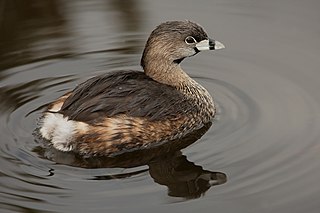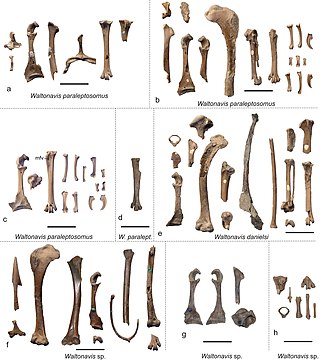
Grebes are aquatic diving birds in the order Podicipediformes. Grebes are widely distributed freshwater birds, with some species also found in marine habitats during migration and winter. Some flightless species exist as well, most notably in stable lakes. The order contains a single family, the Podicipedidae, which includes 22 species in six extant genera. Although, superficially, they resemble other diving birds such as loons and coots, they are most closely related to flamingos, as supported by morphological, molecular and paleontological data. Many species are monogamous and are known for their courtship displays, with the pair performing synchronized dances across the water's surface. The birds build floating vegetative nests where they lay several eggs. About a third of the world's grebes are listed at various levels of conservation concerns—the biggest threats including habitat loss, the introduction of invasive predatory fish and human poaching. As such, three species have gone extinct.

Ciconia is a genus of birds in the stork family. Six of the seven living species occur in the Old World, but the maguari stork has a South American range. In addition, fossils suggest that Ciconia storks were somewhat more common in the tropical Americas in prehistoric times.

Pelagornis is a widespread genus of prehistoric pseudotooth birds. These were probably rather close relatives of either pelicans and storks, or of waterfowl, and are here placed in the order Odontopterygiformes to account for this uncertainty.
Dow's puffin is an extinct seabird in the auk family described in 2000 from subfossil remains found in the Channel Islands of California. It was approximately as large as the modern horned puffin and its beak appared to have been an intermediate between the rhinoceros auklet and the horned puffin. It lived during the Late Pleistocene and Early Pleistocene on the Channel Islands, where it nested alongside the ancient murrelet, Cassin's auklet and Chendytes lawi.
Phoenicopterus minutus is an extinct species of flamingo which inhabited California during the Late Pleistocene. It was originally discovered in San Bernardino County, California in the Lake Manix beds, where it coexisted with a second, larger flamingo species.

Spheniscus muizoni is an extinct species of banded penguins that lived during the early Late Miocene in what is now Peru, South America. The species, the earliest member of the extant genus, was described in 2007 by Ursula B. Göhlich based on fossils found in the fossiliferous Pisco Formation of the Pisco Basin, southwestern Peru.
Annakacygna is a genus of flightless marine swan from the Miocene of Japan. Named in 2022, Annakacygna displays a series of unique adaptations setting it apart from any other known swan, including a filter feeding lifestyle, a highly mobile tail and wings that likely formed a cradle for their hatchlings in a fashion similar to modern mute swans. Additionally, it may have used both wings and tail as a form of display. All of these traits combined have led the researchers working on it to dub it "the ultimate bird". Two species are known, A. hajimei, which was approximately the size of a black swan, and A. yoshiiensis which exceeded the mute swan in both size and weight. The describing authors proposed the vernacular name Annaka short-winged swan for the genus.
Jabiru codorensis is an extinct species of stork related to the extant Jabiru. It lived in what is now Venezuela during the Pliocene period and appears to have been similar to its modern relative.
Melanerpes shawi is an extinct species of woodpecker from the Pleistocene of California. It was found in the La Brea tar pits. It's part of the genus Melanerpes, which includes twenty-four extant species found across North and South America.
Phoeniconaias siamensis is an extinct species of flamingo that lived in northern Thailand during the Miocene period. Its closest living relative is the lesser flamingo.
Phoeniconaias proeses is an extinct species of flamingo from the Pliocene of Australia. Fossil material was described under several names including Ocyplanus proeses and Phoeniconaias gracilis, which were eventually found to be synonymous. Only material from the Tirari Formation has been dated, while most other material lacks precise information on its age. P. proeses was one of the smallest species of flamingo, smaller than the modern lesser flamingo which it may be related to.
Gavia howardae is an extinct species of loon from the Piacenzian age from United States. Fossils of this bird were initially found in 1947 by Clifford Kennell in the San Diego Formation, California and were given a name in 1953 by Pierce Brodkorb. These first specimens consisted of humeri bones, which Brodkorb indicated based on the distal end of the humerus were a smaller species of the genus Gavia, with a possible relationship with the pacific loon. More specimens were collected from the same deposits covering the entirety of the wing, some more complete than others. Chandler (1990) described and published these new materials and found G. howardae to be related to the red-throated loon instead. Additional material has been recovered from the Yorktown Formation, North Carolina where in addition more wing bones, there were also remains of the leg and shoulder regions. Based on the overall size of the remains, G. howardae was on average smaller than the red-throated loon, and one of the smallest species of Neogene loons from North America.

Thiornis is a fossil genus of Middle Miocene grebe known from a nearly complete specimen from Libros, Spain. Originally classified as a type of moorhen, Thiornis has since been classified as a species of grebe. The overall anatomy of the bird is identical to modern grebes. It contains a single species, T. sociata.
Miodytes is a fossil genus of grebe known from a nearly complete specimen from Valjevo Basin, western Serbia known from an almost complete right wing skeleton. It contains a single species, M. serbicus.
Pliolymbus is a fossil genus of grebe known from the Late Pliocene to Early Pleistocene of United States and Mexico. It is known from a single species, P. baryosteus.

Ypresiglaux is an extinct genus of strigiform bird from the Early Eocene London Clay Formation of Essex, United Kingdom and Nanjemoy Formation of Virginia, United States. The genus contains two species: Y. michaeldanielsi, known from a partial skeleton, and Y. gulottai, known from a distal tarsometatarsus.

Waltonavis is an extinct genus of potentially leptosomiform bird from the Early Eocene London Clay Formation of Essex, United Kingdom. The genus contains two species: W. paraleptosomus and W. danielsi, both known from partial skeletons.
Podilymbus majusculus is an extinct species of grebe recovered from the Piacenzian age of the United States.
Podiceps csarnotanus is an extinct species of Upper Pliocene grebe from Hungary.
Podiceps howardae is a possible extinct species of grebe from the United States, possibly a larger and earlier form of the horned grebe.






